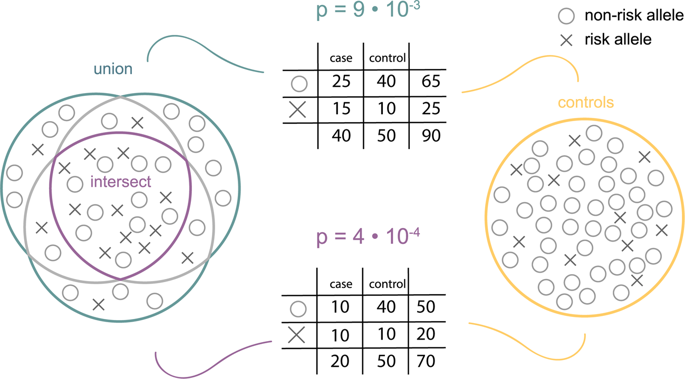当前位置:
X-MOL 学术
›
Eur. J. Hum. Genet.
›
论文详情
Our official English website, www.x-mol.net, welcomes your
feedback! (Note: you will need to create a separate account there.)
Alternate approach to stroke phenotyping identifies a genetic risk locus for small vessel stroke.
European Journal of Human Genetics ( IF 3.7 ) Pub Date : 2020-02-11 , DOI: 10.1038/s41431-020-0580-5 Joanna von Berg 1 , Sander W van der Laan 2 , Patrick F McArdle 3 , Rainer Malik 4 , Steven J Kittner 5 , Braxton D Mitchell 3 , Bradford B Worrall 6 , Jeroen de Ridder 1, 7 , Sara L Pulit 1, 8, 9
European Journal of Human Genetics ( IF 3.7 ) Pub Date : 2020-02-11 , DOI: 10.1038/s41431-020-0580-5 Joanna von Berg 1 , Sander W van der Laan 2 , Patrick F McArdle 3 , Rainer Malik 4 , Steven J Kittner 5 , Braxton D Mitchell 3 , Bradford B Worrall 6 , Jeroen de Ridder 1, 7 , Sara L Pulit 1, 8, 9
Affiliation

|
Ischemic stroke (IS), caused by obstruction of cerebral blood flow, is one of the leading causes of death. While neurologists agree on delineation of IS into three subtypes (cardioembolic stroke (CES), large artery stroke (LAS), and small vessel stroke (SVS)), several subtyping systems exist. The most commonly used systems are TOAST (Trial of Org 10172 in Acute Stroke Treatment) and CCS (Causative Classification System for Stroke), but agreement is only moderate. We have compared two approaches to combining the existing subtyping systems for a phenotype suited for a genome-wide association study (GWAS). We used the NINDS Stroke Genetics Network dataset (SiGN, 11,477 cases with CCS and TOAST subtypes and 28,026 controls). We defined two new phenotypes: the intersect, for which an individual must be assigned the same subtype by CCS and TOAST; and the union, for which an individual must be assigned a subtype by either CCS or TOAST. The union yields the largest sample size while the intersect yields a phenotype with less potential misclassification. We performed GWAS for all subtypes, using the original subtyping systems, the intersect, and the union as phenotypes. In each subtype, heritability was higher for the intersect compared with the other phenotypes. We observed stronger effects at known IS variants with the intersect compared with the other phenotypes. With the intersect, we identify rs10029218:G>A as an associated variant with SVS. We conclude that this approach increases the likelihood to detect genetic associations in ischemic stroke.
中文翻译:

中风表型的替代方法可确定小血管中风的遗传风险位点。
缺血性中风(IS)是由脑血流阻塞引起的,是导致死亡的主要原因之一。虽然神经学家同意将 IS 分为三种亚型(心源性卒中 (CES)、大动脉卒中 (LAS) 和小血管卒中 (SVS)),但仍存在多种亚型系统。最常用的系统是 TOAST(急性中风治疗 Org 10172 试验)和 CCS(中风病因分类系统),但一致性程度较低。我们比较了两种结合现有亚型分型系统以获得适合全基因组关联研究 (GWAS) 的表型的方法。我们使用 NINDS 中风遗传学网络数据集(SiGN,11,477 例 CCS 和 TOAST 亚型病例以及 28,026 例对照)。我们定义了两种新的表型:交叉,必须通过 CCS 和 TOAST 为个体分配相同的亚型;和联合体,必须通过 CCS 或 TOAST 为个体分配子类型。并集产生最大的样本量,而相交产生潜在误分类较少的表型。我们使用原始子分型系统、相交和并集作为表型,对所有亚型进行了 GWAS。在每个亚型中,与其他表型相比,交叉的遗传力较高。与其他表型相比,我们观察到具有交叉的已知 IS 变体具有更强的效果。通过相交,我们将 rs10029218:G>A 识别为与 SVS 相关的变体。我们的结论是,这种方法增加了检测缺血性中风遗传关联的可能性。
更新日期:2020-02-11
中文翻译:

中风表型的替代方法可确定小血管中风的遗传风险位点。
缺血性中风(IS)是由脑血流阻塞引起的,是导致死亡的主要原因之一。虽然神经学家同意将 IS 分为三种亚型(心源性卒中 (CES)、大动脉卒中 (LAS) 和小血管卒中 (SVS)),但仍存在多种亚型系统。最常用的系统是 TOAST(急性中风治疗 Org 10172 试验)和 CCS(中风病因分类系统),但一致性程度较低。我们比较了两种结合现有亚型分型系统以获得适合全基因组关联研究 (GWAS) 的表型的方法。我们使用 NINDS 中风遗传学网络数据集(SiGN,11,477 例 CCS 和 TOAST 亚型病例以及 28,026 例对照)。我们定义了两种新的表型:交叉,必须通过 CCS 和 TOAST 为个体分配相同的亚型;和联合体,必须通过 CCS 或 TOAST 为个体分配子类型。并集产生最大的样本量,而相交产生潜在误分类较少的表型。我们使用原始子分型系统、相交和并集作为表型,对所有亚型进行了 GWAS。在每个亚型中,与其他表型相比,交叉的遗传力较高。与其他表型相比,我们观察到具有交叉的已知 IS 变体具有更强的效果。通过相交,我们将 rs10029218:G>A 识别为与 SVS 相关的变体。我们的结论是,这种方法增加了检测缺血性中风遗传关联的可能性。









































 京公网安备 11010802027423号
京公网安备 11010802027423号